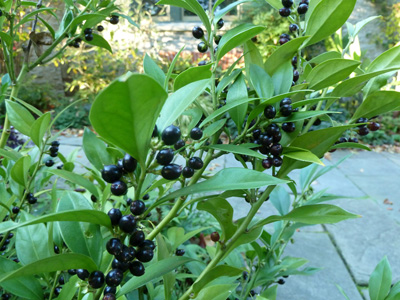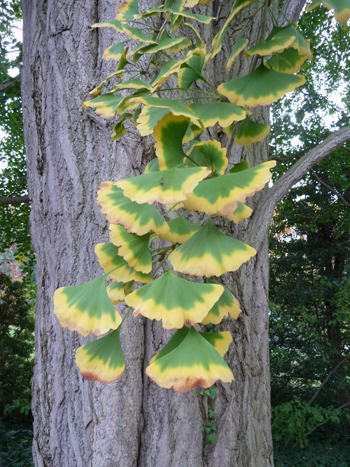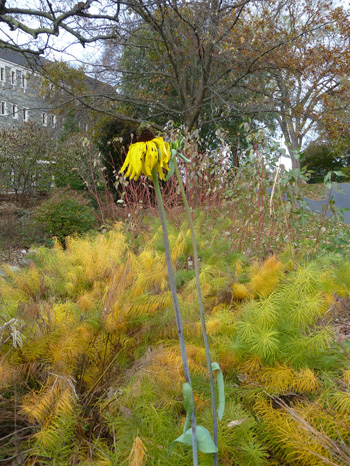Plants of the Week – November 5
 Hamamelis virginiana are in bloom throughout the Scott Arboretum and Crum Woods. Hamamelis reproduce mainly by seed. After maturing, the capsules burst open, explosively discharging their seeds several yards from the parent plant. European settlers, unfamiliar with the North American native, thought the plant a hazel as it bore resemblance to Corylus. After hearing a chorus of explosions produced by multitudes of H. virginiana, the settlers dubbed the plant “be-witched hazel.” The name stuck and gave rise to the familiar common name of witchhazel. According to the USDA Forest Service, the fruit of witchhazel is eaten by ruffed grouse, northern bobwhite, ring-necked pheasant, and white-tailed deer. Photo credit: J. Coceano
Hamamelis virginiana are in bloom throughout the Scott Arboretum and Crum Woods. Hamamelis reproduce mainly by seed. After maturing, the capsules burst open, explosively discharging their seeds several yards from the parent plant. European settlers, unfamiliar with the North American native, thought the plant a hazel as it bore resemblance to Corylus. After hearing a chorus of explosions produced by multitudes of H. virginiana, the settlers dubbed the plant “be-witched hazel.” The name stuck and gave rise to the familiar common name of witchhazel. According to the USDA Forest Service, the fruit of witchhazel is eaten by ruffed grouse, northern bobwhite, ring-necked pheasant, and white-tailed deer. Photo credit: J. Coceano
 Sarcococca orientalis has been especially fruitful this year. Introduced from Jiangxi in eastern China by Roy Lancaster, the Oriental sweet box bears slightly arching branches with shiny green leaves which are larger than those of other species. Polished black fruit develop from fragrant white flowers. Photo credit: J. Coceano
Sarcococca orientalis has been especially fruitful this year. Introduced from Jiangxi in eastern China by Roy Lancaster, the Oriental sweet box bears slightly arching branches with shiny green leaves which are larger than those of other species. Polished black fruit develop from fragrant white flowers. Photo credit: J. Coceano
 Ginkgo biloba, once thought to be extinct, was rediscovered in China in the mid-1700s. Ginkgo is derived from the Japanese word ginkyo meaning “silver apricot” referring to the fruits which are consumed in Japan. The specific epithet biloba refers to the split in the middle of the fan-shaped leaves. Ginkgos, known for their picturesque quality and golden fall color, often develop yellow margins on the leaves as their pigments transition from green to yellow. Photo credit: J. Coceano
Ginkgo biloba, once thought to be extinct, was rediscovered in China in the mid-1700s. Ginkgo is derived from the Japanese word ginkyo meaning “silver apricot” referring to the fruits which are consumed in Japan. The specific epithet biloba refers to the split in the middle of the fan-shaped leaves. Ginkgos, known for their picturesque quality and golden fall color, often develop yellow margins on the leaves as their pigments transition from green to yellow. Photo credit: J. Coceano
 A single flower of Rudbeckia maxima perseveres through the chill of early November. This herbaceous perennial is found throughout the Biostream. Basal clumps of large, glaucous, paddle-shaped leaves give rise to yellow coneflower-like flowers atop tall stems. Native to central and southeastern United States, Rudbeckia maxima seeds are a favorite among bird species, particularly goldfinches. Photo credit: J. Coceano
A single flower of Rudbeckia maxima perseveres through the chill of early November. This herbaceous perennial is found throughout the Biostream. Basal clumps of large, glaucous, paddle-shaped leaves give rise to yellow coneflower-like flowers atop tall stems. Native to central and southeastern United States, Rudbeckia maxima seeds are a favorite among bird species, particularly goldfinches. Photo credit: J. Coceano





Lynn Etheredge
Posted at 15:46h, 08 NovemberThanks for mentioning Rudbeckia maxima as a favorite of birds. When i was at the Perennilal Plant conference i saw a lot of birds enjoying the Biostream. What are the other bird favorites there?
Josh Coceano
Posted at 13:39h, 13 NovemberGreat question. Fall is a great time to observe which plants are favorites among birds. A few that attract birds include Sorbus alnifolia, Callicarpa, Chionanthus, and Ilex verticillata.